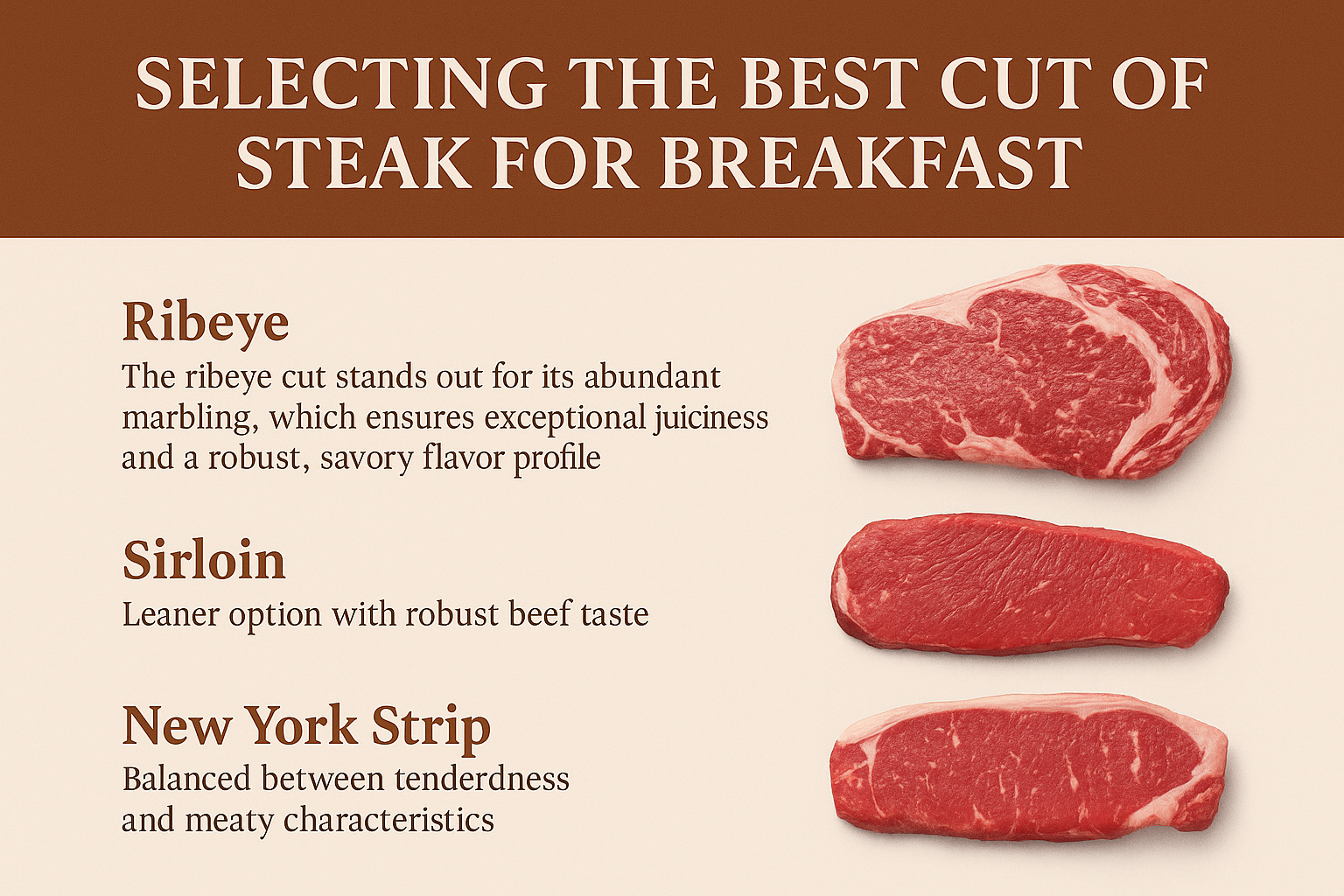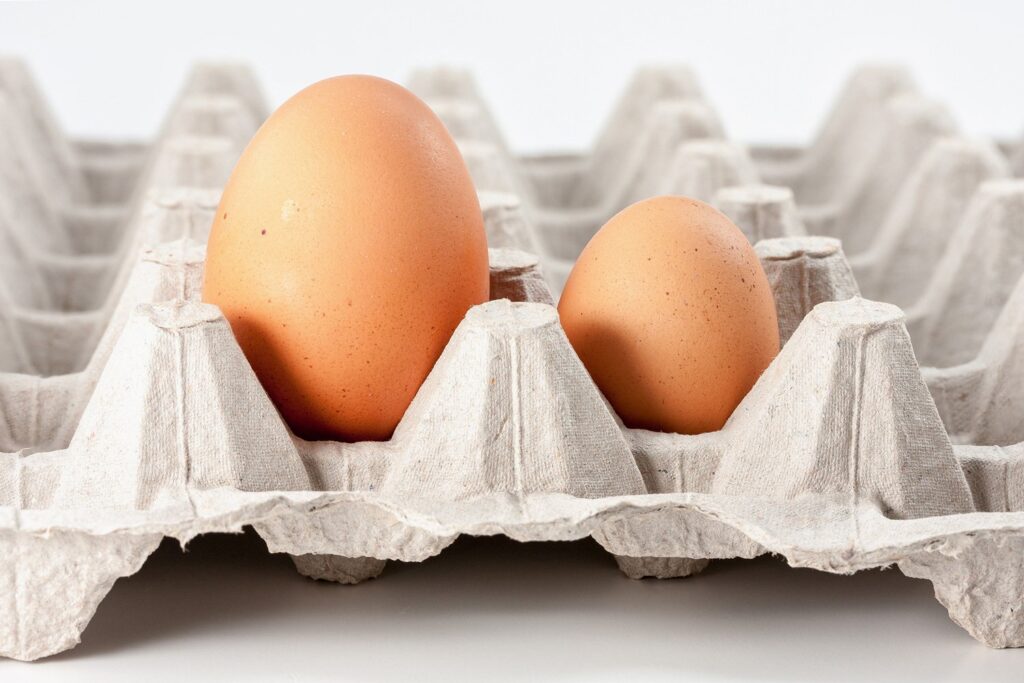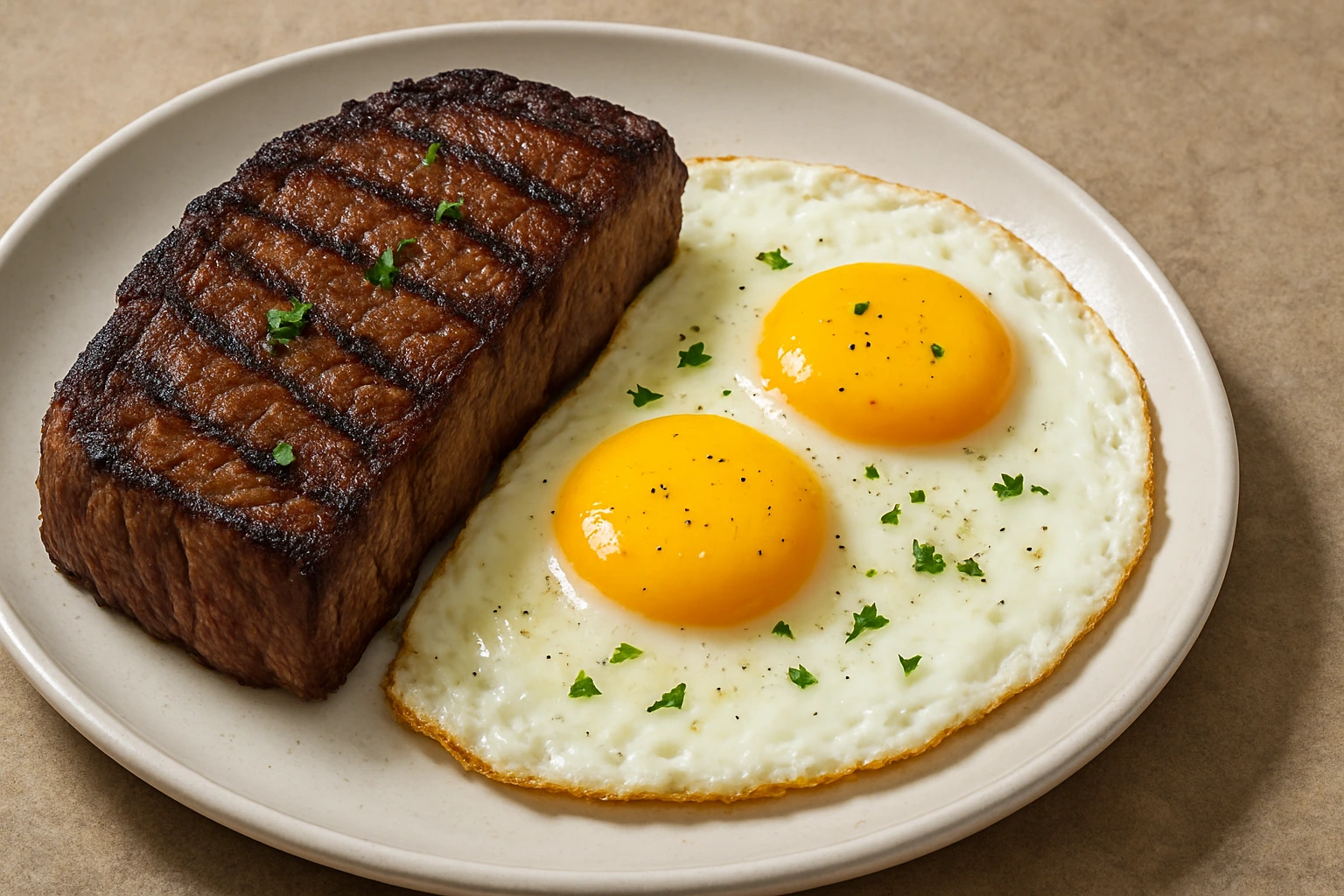Steak and eggs
Table of Contents
Steak and eggs are the ultimate breakfast, loved by many in the U.S. They offer a mix of rich flavors and great nutrition. This combo is perfect for starting your day off right.
Getting steak and eggs just right takes skill and a few secrets. Whether you cook at home or dream of being a chef, knowing the basics can make your breakfast stand out. It can taste like it’s from a fancy restaurant.
In this guide, we’ll share three key tips for cooking steak and eggs that always turn out great. You’ll learn how to pick the best meat and cook it to the perfect temperature. We’ll also show you how to add extra flavor to your dish.
Key Takeaways
- Learn professional techniques for cooking steak and eggs
- Understand temperature control for perfect doneness
- Discover flavor enhancement strategies
- Recognize the importance of ingredient quality
- Master timing and preparation methods
Essential Equipment for the Perfect Steak and Eggs
Creating a tasty steak and eggs breakfast needs more than just good ingredients. The right kitchen tools can make your meal go from good to great. Professional chefs say choosing the best equipment is key for a memorable meal.
Cast Iron Skillet Care and Preparation
A cast-iron skillet is the best friend for cooking steak and eggs. These pans keep heat well and cook evenly, giving your steak a perfect sear. To keep your skillet in top shape:
- Season the skillet often with oil that doesn’t smoke easily
- Clean it without soap, using hot water and a hard brush
- Make sure it’s dry after each use to avoid rust
- Put a thin layer of cooking oil on it after cleaning
Must-Have Kitchen Tools
Equipping your kitchen with essential tools—such as a sharp chef’s knife, heavy-duty tongs, and a cast-iron skillet—enhances culinary precision and elevates meal preparation. You’ll need:
- A sharp chef’s knife for cutting meat wel
- Strong tongs for handling hot meat
- An instant-read meat thermometer
- A heavy-duty cutting board

A heavy-duty cutting board
Getting the temperature right is crucial for perfect steak and eggs. Use tools that help you control the temperature well. An infrared thermometer and digital meat thermometer are great for this.
Pro tip: Always let your cast-iron skillet preheat slowly. This ensures even heat and the best sear on your steak.
Selecting the Best Cut of Steak for Breakfast
Choosing the right steak can make your diner cuisine experience amazing. Crafting a timeless brunch dish like steak and eggs hinges on selecting high-quality meat, as the steak’s tenderness and taste define the meal’s success. It gives you great flavor and texture.
For breakfast lovers, some top steak cuts are:

- The ribeye cut stands out for its abundant marbling, which ensures exceptional juiciness and a robust, savory flavor profile
- Sirloin: Leaner option with robust beef taste
- New York Strip: Balanced between tenderness and meaty characteristics
The ribeye is the top choice for diner cuisine indulgence. Its fat content makes it juicy and flavorful. This boosts the traditional brunch classic. Home cooks aiming for restaurant-quality should focus on meat quality and preparation.
When picking your steak, think about these important factors:
- Thickness (aim for 1-1.5 inches)
- Marbling quality
- Grade of beef (USDA Prime recommended)
Professional chefs know the right cut is crucial for a memorable breakfast. High-quality meat turns a simple meal into a special experience. It celebrates the timeless appeal of steak and eggs.
Understanding Egg Grades and Freshness

Choosing the right eggs is key for a great hearty dish. Eggs are more than just a simple ingredient. They’re a crucial part of your breakfast that can make it amazing.
The quality of eggs depends on several important factors. Every home cook should know about these. From freshness to grade, each factor plays a big role in your morning meal.
Free Range vs. Conventional Eggs
When picking eggs, you’ll find two main types:
- Free Range Eggs: Chickens have outdoor access and make more nutritious eggs
- Conventional Eggs: Produced in standard farms with less chicken movement
Storage and Temperature Guidelines
Storing eggs right keeps them fresh and safe. Here are some key tips:
| Storage Location | Temperature | Maximum Storage Time |
| Refrigerator | 40°F or below | 3-5 weeks |
| Room Temperature | 68-77°F | 2 hours maximum |
Size Selection for Perfect Pairing
Egg sizes matter a lot for your hearty dish. Large eggs are best for steak and eggs. They give enough volume without overpowering the steak.
- Large eggs: Most versatile for morning sustenance
- Extra-large eggs: Best for bigger appetites
- Medium eggs: Ideal for lighter breakfast portions
By knowing these egg selection tips, you’ll make a balanced and tasty breakfast every time.
The Classic Steak and Eggs Combination
Steak and eggs are more than a meal. They are a deep part of American cattle ranch fare. This combo came from ranch workers needing lots of food for long, hard days.
The start of steak and eggs goes back to the late 1800s. Ranch workers relied on a protein-rich breakfast to fuel their demanding daily labor Cattle ranch fare showed their hard work and strength.
“A good steak and eggs breakfast is like fuel for the soul” – Ranch Cook Wisdom
- Provides high-protein start to the day
- Represents traditional American breakfast culture
- Connects modern dining to historical agricultural practices
Now, steak and eggs are a favorite brunch choice in the U.S. They still stand for strength, simplicity, and great taste.
| Era | Steak and Eggs Significance |
| Late 1800s | Ranch Worker Staple |
| Mid-1900s | Diner Standard |
| Present Day | Gourmet Breakfast Option |
Steak and eggs are loved on ranches and in fancy restaurants. They are a classic that still delights food fans everywhere.
Mastering the Perfect Steak Temperature
Cooking the ideal meat and eggs breakfast meal needs precision and knowing steak temperatures. Getting the perfect doneness turns a simple meal into a feast that pleases everyone.
Controlling temperature is key to a memorable meat and eggs dish. It makes your steak juicy, flavorful, and cooked just right.
Rare to Well-Done Temperature Guide
- Rare: 125°F (internal temperature), bright red center
- Medium Rare: 135°F, warm red center
- Medium: 145°F, pink center
- Medium Well: 150°F, slight pink center
- Well Done: 160°F, no pink
Resting Time Importance
After cooking, let your steak rest for 5-10 minutes. This step makes the meat tender and flavorful. Covering it loosely with foil keeps it warm.
Temperature Monitoring Methods
- Digital instant-read meat thermometer
- Infrared temperature gun
- Analog probe thermometer
“The difference between a good steak and a great steak is often just a few degrees.” – Professional Chef
Getting better at steak temperatures takes practice and patience. Follow these tips, and your meat and eggs breakfast will always be a hit.
Expert Techniques for Egg Preparation
Learning how to prepare eggs can make your morning meal amazing. Each way of cooking eggs adds its own special touch. This makes your steak and eggs even better.
Professional chefs have some top tips for cooking eggs:
- Sunny-Side Up: Keep yolks runny with crispy white edges
- Over-Easy: Gently flipped with a soft, liquid center
- Scrambled: Creamy, soft curds for ultimate comfort
- Poached: Delicate technique for restaurant-quality presentation
It’s important to control the temperature when cooking eggs
. Each method needs a certain heat to get the right result.
| Egg Method | Ideal Temperature | Cooking Time |
| Sunny-Side Up | Medium-Low | 2-3 minutes |
| Over-Easy | Medium | 1-2 minutes per side |
| Scrambled | Low-Medium | 3-4 minutes |
| Poached | Simmering Water | 3 minutes |
With practice and patience, you’ll get better at these egg cooking techniques. Soon, your breakfast will be a true work of art.
Seasoning Secrets for Maximum Flavor
To make a basic diner dish into a flavorful feast, you need to master seasoning. The right mix of herbs, spices, and techniques can turn your steak and eggs into a standout dish.
Dry Rubs: Flavor Foundations
Dry rubs add a flavor crust that makes every bite special. Here are the key ingredients:
- Kosher salt as the primary base
- Coarse ground black pepper
- Smoked paprika for depth
- Garlic powder for complexity
Salt Timing and Techniques
Salting is an art that adds to a dish’s flavor. Chefs suggest:
- Salting steaks 40 minutes before cooking
- Using coarse kosher salt
- Patting meat dry before seasoning
Herb and Spice Combinations
Discover restaurant-quality flavors with these herb pairings:
| Herb Combination | Best Paired With | Flavor Profile |
| Rosemary & Thyme | Ribeye Steak | Earthy, Robust |
| Oregano & Basil | Sirloin | Mediterranean Brightness |
| Sage & Parsley | New York Strip | Subtle, Refined |
“Great seasoning transforms a simple meal into a culinary experience.” – Professional Chef
Try out these seasoning tips to make your diner dish as good as a restaurant’s. Your breakfast will become a memorable feast.
Timing Your Cooking Process
Mastering the timing for a brunch classic like steak and eggs is key. It’s all about getting both parts right. This means cooking them at the perfect time.
Using a cast-iron skillet makes timing even more important. Its great heat retention means you must be precise.Ensure all ingredients and tools are prepared and organized before beginning the cooking process.
.
- Allow the steak to sit at room temperature for 30 minutes prior to cooking for even heat distribution.
- Heat cast-iron skillet on medium-high heat
- Cook steak first, then set aside to rest
- Use same skillet to prepare eggs immediately after
Cooking times depend on your steak’s doneness and egg style. Here’s a quick guide to help you time it right:
| Steak Doneness | Cooking Time | Egg Style | Cooking Time |
| Rare | 3-4 minutes | Over Easy | 2-3 minutes |
| Medium Rare | 4-5 minutes | Sunny Side Up | 2-3 minutes |
| Medium | 5-6 minutes | Scrambled | 3-4 minutes |
Pro tip: Always let your steak rest for 5-7 minutes after cooking to ensure juicy, flavorful results.
“Timing is everything in cooking. With practice, you’ll create a perfect steak and eggs every time.” – Professional Chef
Complimentary Side Dishes and Garnishes
Turning a basic breakfast into a feast is all about the sides and garnishes. The right choices can make steak and eggs a true delight. It’s about taking a simple meal and making it unforgettable.
Choosing the right sides lets you make your dish your own. It adds nutrition and makes the meal look great. The goal is to enhance the steak and eggs without taking over.
Traditional Pairings
Classic ranch fare often includes hearty sides. These dishes reflect old-school cooking:
- Crispy hash browns
- Buttermilk biscuits
- Grilled country potatoes
- Warm sourdough toast
- Sautéed mushrooms
Modern Accompaniments
For a modern twist, try these fancy garnishes:
- Roasted asparagus spears
- Avocado salsa
- Microgreen garnishes
- Truffle-infused hollandaise
- Chimichurri sauce
These additions bring new textures and tastes. They turn a simple breakfast into a special meal.
“Great food is about creating memories at the table” – Unknown Chef
Common Mistakes to Avoid
Making the perfect steak and eggs breakfast can be tricky. Even experienced cooks can make simple mistakes. These mistakes can ruin the flavor and texture of your dish.
Here are the most critical mistakes to watch out for when preparing your steak and eggs:
- Temperature Misjudgment: Not letting meat and eggs warm up before cooking can cause uneven cooking
- Using dull or low-quality cooking knives that tear meat instead of creating clean cuts
- Overcrowding the pan, which prevents proper heat distribution
- Flipping the steak too frequently, disrupting the crucial caramelization process
Seasoning is another tricky part of making steak and eggs. Putting salt on too early can make the meat dry. Season just before cooking with kosher salt and freshly ground black pepper for the best flavor.
When cooking eggs, avoid using high heat. It can make the whites tough and the yolks overcooked. Cooking at medium-low temperature keeps your eggs tender and creamy.
“Cooking is about confidence. Learn from mistakes, and you’ll become a better chef with each attempt.” – Professional Chef’s Wisdom
Remember, mastering steak and eggs takes practice. Don’t get discouraged by initial setbacks. Each cooking session is a chance to get better at your culinary skills.
Plating and Presentation Tips
Turning your steak and eggs into a fancy brunch classic is all about how it looks. Presentations can make your meal look like it was made by a pro. It’s all about making it visually appealing.
Restaurant-Style Arrangements
Here are some tips for making your plate look amazing:
- Place the steak at a 45-degree angle for a cool look
- Choose white plates to make colors stand out
- Stack eggs or use a garnish riser to add height
- Make sure to wipe the plate edges clean for a sharp look
Garnishing Techniques
Here’s how to add a fancy touch to your brunch:
- Top with fresh herbs like chives or parsley for color
- Try microgreens for a fancy texture
- Drizzle infused oils around the plate’s edge
- Add a small salt flower or cracked pepper for a finishing touch
Remember, how it looks is just as important as how it tastes. By practicing these tips, you’ll impress your guests with a pro-quality presentation.
Conclusion
Preparing the perfect steak and eggs needs skill, passion, and detail. By learning about temperature control and choosing quality ingredients, you can make this classic dish shine at home. It’s all about mastering cooking techniques.
The path to making great meat and eggs is more than just recipes. It’s about getting better in the kitchen, knowing how steak and eggs react to heat, and cooking eggs just right. Every try gets you closer to being a pro.
With the tips from this guide, you can cook a tasty breakfast that fills you up and delights your taste buds. Remember, the more you practice, the better you’ll get. Every meal is a chance to improve your steak and eggs game.
So, dive into the process, try new flavors, and feel the joy of serving a top-notch steak and eggs breakfast. It will surely wow your family and friends.
FAQ
What’s the best cut of steak for steak and eggs?
Ribeye and sirloin are great choices for steak and eggs. They have lots of marbling, making them tender and flavorful. Strip steak is also excellent, offering a mix of lean meat and rich taste for breakfast.
How do I achieve the perfect steak temperature for breakfast?
Use a meat thermometer to check the steak’s doneness. For medium-rare, aim for 135°F, and medium at 145°F. Let the steak rest for 5-7 minutes after cooking. This ensures it stays juicy and flavorful.
What type of skillet works best for steak and eggs?
A cast-iron skillet is the best for steak and eggs. It keeps heat well, sears the steak beautifully, and can go from stovetop to oven. Make sure it’s well-seasoned for the best diner-style breakfast.
How fresh do my eggs need to be?
Use the freshest eggs possible for the best breakfast. Check the carton’s date and look for eggs with firm yolks and whites. Free-range eggs often taste better and are more nutritious.
What are some common mistakes to avoid when cooking steak and eggs?
Avoid overcooking the steak and make sure your pan is hot before cooking. Don’t move the steak too much while searing. Be careful not to break the egg yolk if you like it whole. Let the steak rest after cooking and season well for the best experience.
Can I prepare steak and eggs for meal prep?
While steak and eggs are best fresh, you can prepare some things ahead. Season the steak in advance and have ingredients ready. Cook the steak and eggs just before serving for the best taste and texture. Eggs should be cooked immediately for the best flavor.
What are some classic side dishes to serve with steak and eggs?
Classic brunch sides include hash browns, toast, grilled tomatoes, sautéed mushrooms, and fresh fruit. For a modern twist, try avocado slices, roasted sweet potatoes, or a light mixed green salad. These add variety to your protein-packed breakfast.

